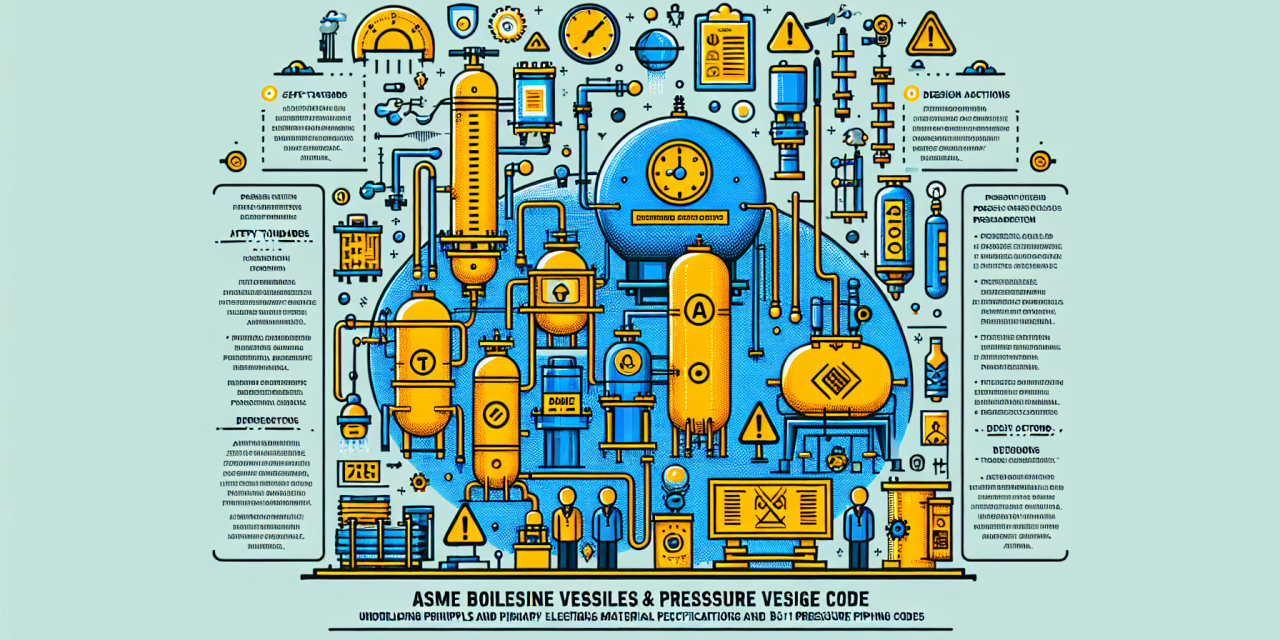Table of Contents
- Introduction
- What Are ASME Codes?
- Understanding the ASME Boiler and Pressure Vessel Code (BPVC)
- Structure of the BPVC
- Key Requirements of the BPVC
- Understanding the B31 Pressure Piping Codes
- Structure of the B31 Codes
- Key Requirements of the B31 Codes
- The Importance of Compliance with ASME Codes
- Training and Resources for ASME Codes
- FAQs
- Conclusion
Introduction
In the engineering world, standards and codes play a crucial role in ensuring safety, reliability, and efficiency. Among these standards, the ASME Boiler & Pressure Vessel Code and the B31 Pressure Piping Codes stand out as foundational guidelines for industries dealing with boilers, pressure vessels, and piping systems. By understanding these codes, professionals can ensure compliance, enhance operational efficiency, and maintain safety in their operations.
What Are ASME Codes?
ASME, which stands for the American Society of Mechanical Engineers, sets industry standards that govern the design, construction, operation, and maintenance of mechanical systems. These codes are not merely suggestions; they provide a framework that ensures entities adhere to safety and operational benchmarks.
Importance of ASME Codes
Understanding and implementing ASME codes is vital for several reasons:
- Safety: The primary goal of ASME codes is to protect life and property by minimizing risks associated with pressure vessels and piping systems.
- Regulatory Compliance: Many jurisdictions require adherence to these codes, making them a legal necessity.
- Operational Efficiency: Following these codes can enhance system performance, reduce downtime, and improve maintenance practices.
Understanding the ASME Boiler and Pressure Vessel Code (BPVC)
The ASME Boiler & Pressure Vessel Code, often abbreviated as BPVC, is a set of standards that governs the design, fabrication, inspection, and maintenance of boilers and pressure vessels. This extensive document spans numerous divisions and is essential for ensuring that pressure vessels operate safely and efficiently.
Historical Background
The BPVC has evolved over the years, adapting to changing technologies and safety standards. Originating in the early 20th century, today it comprises various sections, each focusing on different aspects of boiler and pressure vessel design and use.
Sections of the BPVC
The BPVC is divided into several sections that cover various topics:
- Section I: Power Boilers
- Section II: Materials (Specifications)
- Section III: Nuclear Facility Components
- Section IV: Heating Boilers
- Section V: Nondestructive Examination
- Section VI: Recommended Rules for the Care and Operation of Heating Boilers
- Section VII: Guidelines for the Care of Power Boilers
- Section VIII: Pressure Vessels
- Section IX: Welding and Brazing Qualifications
- Section X: Fiber-Reinforced Plastic Pressure Vessels
- Section XI: Rules for In-Service Inspection of Nuclear Power Plant Components
Key Requirements of the BPVC
The BPVC contains essential requirements that every engineer and manufacturer must follow, including:
- Material Specifications: Ensuring the materials used in construction meet quality standards.
- Design Rules: Following stipulated design principles to ensure structural integrity.
- Fabrication and Assembly: Adhering to specific methods and procedures during manufacturing.
- Inspection Criteria: Carrying out inspections at various stages to verify compliance with standards.
- Testing Procedures: Conducting pressure tests and other evaluations to confirm operational safety.
Understanding the B31 Pressure Piping Codes
The B31 Pressure Piping Codes, developed by ASME, establish guidelines for the design, materials, fabrication, installation, and inspection of piping systems. These codes ensure that pressure piping systems operate safely and efficiently across various industries.
Key Sections of B31 Codes
The B31 Codes are divided into several parts, each addressing specific piping requirements:
- B31.1: Power Piping
- B31.2: Fuel Gas Piping
- B31.3: Process Piping
- B31.4: Pipeline Transportation Systems for Liquid Hydrocarbons and Other Liquids
- B31.5: Refrigeration Piping
- B31.8: Gas Transmission and Distribution Piping Systems
- B31.9: Building Services Piping
Importance of B31 Codes
Implementing B31 codes is significant for several reasons:
- Safety Assurance: These codes help mitigate risks related to piping failures.
- Standardization: B31 codes create standardized procedures for the design and installation of piping systems.
- Legal Compliance: Many regulations mandate compliance with B31 codes.
Key Requirements of the B31 Codes
The B31 codes specify crucial requirements for the safe operation of pressure piping systems, including:
- Material Selection: Choosing materials that withstand operational pressures and temperatures.
- Design Calculations: Performing detailed calculations to ensure system integrity under pressure.
- Fabrication Standards: Following strict guidelines for manufacturing components.
- Installation Guides: Adhering to best practices during installation to ensure long-term reliability.
- Inspection and Testing: Implementing regular maintenance and testing protocols to ensure ongoing safety.
The Importance of Compliance with ASME Codes
Compliance with ASME codes is fundamental for any organization involved in designing, manufacturing, and operating pressure vessels and piping systems. Understanding and implementing these codes not only enhances safety but also significantly impacts the company’s bottom line.
Risk Reduction
By adhering to ASME codes, companies can vastly reduce the risk of accidents and equipment failures, which can lead to severe consequences, including injuries, fatalities, and significant financial losses.
Improved Operational Efficiency
Compliance with these codes provides a roadmap for designing efficient systems, thus optimizing overall performance and production rates.
Increased Market Competitiveness
Companies that demonstrate a commitment to safety and quality standards through compliance are often more appealing to clients and regulatory bodies.
Training and Resources for ASME Codes
Understanding ASME codes can be complex, but numerous resources and training programs can ease the learning process. Engaging with structured training can provide invaluable insights into the application of the ASME Boiler & Pressure Vessel Code and the B31 Pressure Piping Codes. A great option for professionals looking to deepen their understanding is the ASME Boiler & Pressure Vessel Code Training – Master BPVC & B31.
Additionally, those interested in implementing quality management systems can explore resources like Your Ultimate Guide to Developing and Implementing an Energy Management System, which offers insights that can complement ASME training.
Furthermore, keeping abreast of the latest trends in operational excellence through articles like Achieving Operational Excellence: Essential Strategies for the Process Industry can provide valuable context in your ASME training journey.
FAQs
What is the ASME Boiler & Pressure Vessel Code (BPVC)?
The ASME BPVC is a set of standards governing the design, fabrication, inspection, and maintenance of boilers and pressure vessels.
Why are ASME codes important?
They ensure safety, regulatory compliance, and operational efficiency in industries that handle pressure vessels and piping.
What types of codes fall under B31?
B31 codes encompass various sections addressing power, process, and gas transmission piping, among others.
How can I learn more about ASME codes?
Engaging with training programs, such as ASME Boiler & Pressure Vessel Code Training – Master BPVC & B31, and reading industry articles can enhance your knowledge.
What is the benefit of compliance with B31 codes?
Compliance reduces risk, improves operational efficiency, and increases competitiveness in the market.
Conclusion
Understanding and applying the ASME Boiler & Pressure Vessel Code and B31 Pressure Piping Codes not only enhances safety and compliance but also fosters a culture of excellence and efficiency within organizations. By investing time and resources into mastering these codes, professionals can significantly improve operational performance and ensure the long-term success of their projects. Remember, safety is paramount, and adhering to these standards is a step towards achieving that goal.





